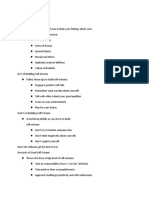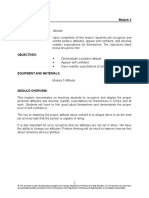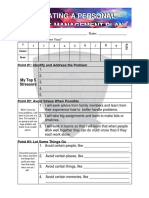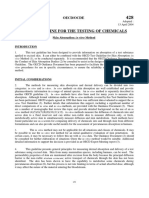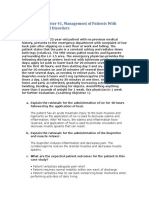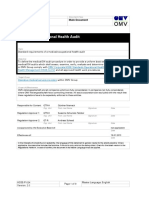POSITIVE
APPROACH
Development Guide
DDI COMPETENCY LIBRARY 3.1
190
© Development Dimensions International, Inc., MMVIII. Revised MMXIV. All rights reserved.
� POSITIVE APPROACH
Demonstrating a positive attitude in the face of difficult or challenging situations; providing an
uplifting (yet realistic) outlook on what the future holds and the opportunities it might present.
Key Actions
• Instills confidence—Communicates confidence in others’ ability to succeed when
people are faced with significant challenges or difficult odds.
• Provides a positive outlook—Looks for and communicates the positive qualities
and longer-term benefits of challenging situations (while facing the real problems).
• Uplifts spirit—Uses an optimistic perspective to motivate others to try harder to
achieve.
QUICK TIPS
• Project an image of optimism and enthusiasm in challenging situations; it’s likely others will
join in your positive outlook.
• In difficult situations seek a balanced perspective, giving due consideration to the positive
aspects or the brighter side of the situation.
• Demonstrate a can-do attitude and encourage others to view challenge as a growth
experience.
• Both positive and negative attitudes can be contagious; work to offset any negativity before
it becomes a group issue.
• Reassure people who are unsure about reaching a goal. Remind them of past
accomplishments or current potential to help alleviate concerns and renew motivation.
• Be positive yet realistic. Express confidence that results can be achieved, while uncovering
any skepticism or resistance. Get resistance out in the open and, with the team, resolve
any concerns early in the project.
Questions to Guide Development
Use these questions to help you determine your level (or your employees level) of proficiency at
this competency.
• How have you fostered positive thinking within your team, department, business unit, or
organization? Walk me through a recent example.
• Sometimes a leader is put "on the spot" about a shortcoming in the organization. How have you
dealt with this sort of situation in the past?
191
© Development Dimensions International, Inc., MMVIII. Revised MMXIV. All rights reserved.
� • Tell me about a time when you had to fight cynical attitudes in your team, department, business
unit, or organization.
• Tell me about a recent time when you were ineffective at motivating your team about an issue.
What happened? What did you learn from that experience?
• Tell me about a time when you had to encourage your team, department, or business unit to
take on a new challenge.
• Describe a situation when you used a corporate communication (e.g., e-mail or social media) to
champion an individual, team, or business unit success.
• Organizations can go through difficult changes that can negatively impact their employees. Tell
me about a time when you had to deliver bad news to your direct reports.
• Tell me about a time when you inspired a group of people to go beyond their usual
performance to deliver exceptional results?
• Tell me about a time when you did more than was required in your own job in order to inspire
others to go above and beyond in their jobs.
• Tell me about a time when you enhanced the reputation of your organization.
• Sometimes teams lose their motivation to perform. Tell me about a time when you needed to
inspire an unmotivated team.
• Tell me about a recent time when the confidence level of your team was down. What did you
say to them?
• Tell me about a time when one of your direct reports / team had an important deadline coming
up but had lost motivation. How did you handle this?
• Tell me about a time when you needed to motivate others to accomplish challenging goals
under time pressure?
• Describe the steps you have taken to show others how you support the organization's vision,
values, or strategic initiatives. Describe a recent example.
• How we communicate information or news can have a powerful impact on those around us.
Describe how you have used various methods of communication to motivate those around you.
Provide a recent example.
• Tell me about a time when you advocated for the organization in order to gain others'
commitment to a new initiative or policy.
DEVELOPMENT ACTIVITIES
Self-Directed
• When managing a project, keep a list of accomplishments as well as challenges. Note your
solutions to problems or obstacles.
192
© Development Dimensions International, Inc., MMVIII. Revised MMXIV. All rights reserved.
� • Be aware of your disposition. Keep track of incidents in which you reacted negatively; think
about how you could have reacted more positively.
• As obstacles in a project or initiative arise or expand, don’t let them undermine your level of
confidence. Use techniques such as team-building events to energize team members and
keep people focused on the results you hope to achieve.
• Observe others whom you respect for their positive disposition. Compare your approach to
interactions or adversity with theirs.
• Devise regular, ongoing methods to inspire team members during projects but especially in
times of challenge or conflict. Inspiring others helps build their commitment to a project or
initiative.
• Stay involved with your team to ensure that negativity does not derail initiatives.
• When anxiety levels increase during a project, lead the effort to regain perspective. Speak
in real terms about the difficulties being experienced and discuss ways to leverage the
team’s strengths.
• Before an interaction consider how you can inspire others toward a desired outcome.
Determine which interpersonal approach would best motivate others toward that outcome.
Be prepared to offer alternatives.
• Assess the disposition of the people in your work group. Identify those with a positive
outlook, as well as others who tend to be skeptical. Consider how your contributions,
approach, or reactions affect them.
Partnerships
• Identify a trusted peer or leader who maintains a consistently positive outlook. Ask that
person how he or she does this every day.
• In your own words, describe your demeanor and outlook. Check your self-perceptions with
a trusted colleague.
• Offer time and guidance to someone who is experiencing anxiety related to a lack of
confidence.
• Ask your leader to include positive disposition in your performance appraisal. Discuss how
the feedback you received and the activities you completed have helped to improve your
disposition.
Targeted Assignments
• Complete professional personality inventories for further insight into the positive and
negative aspects of your disposition. Seek formal feedback on your results and, with results
from other assessments, look for trends in your behavior.
• Attend a seminar on motivational speech. Adapt what you learn to your daily interactions.
193
© Development Dimensions International, Inc., MMVIII. Revised MMXIV. All rights reserved.
� • Volunteer to be a mentor or coach to someone who would like to develop a more positive
disposition.
Workshops
Look for a workshop that addresses the following:
• Maintaining and instilling confidence during adversity.
• Focusing on the positive, or “bright side.”
• Inspiring others and modeling a can-do attitude.
• Identifying and overcoming negativity.
ADDITIONAL LEARNING RESOURCES
Practical Advice
Amabile, T., & Kramer, S. (2011). The progress principle: Using small wins to ignite joy,
engagement, and creativity at work. Boston: Harvard Business Review Press.
Byham, T. M. and Wellins, R. S. (2015). Your first leadership job: How catalyst leaders bring out
the best in others. Hoboken, NJ: John Wiley & Sons.
Cameron, K.S. (2013). Practicing positive leadership: Tools and techniques that create
extraordinary results. San Francisco: Berrett-Koehler.
Fritz, R. (2008). The power of a positive attitude: Discovering the key to success. New York:
AMACOM.
Geisler, J. (2012). Work happy: What great bosses know. New York: Center Street.
Glenn, S. (2010). A kick in the attitude: An energizing approach to recharge your team, work, and
life. Hoboken, NJ: John Wiley & Sons.
Lyttle, J. (2007, May 15). The judicious use and management of humor in the workplace. Business
Horizons, 50(3), 239–245.
Paulson, T. (2010). The optimism advantage: 50 simple truths to transform your attitudes and
actions into results. Hoboken, NJ: John Wiley & Sons.
Quinn, R.W., & Quinn, R.E. (2009). Lift: Becoming a positive force in any situation. Boston:
Davies-Black.
Contemporary and Classic Insights
Amabile, T.M., & Kramer, S.J. (2007, May). Inner work life: Understanding the subtext of business
performance. Harvard Business Review, 85(5), 72–83.
194
© Development Dimensions International, Inc., MMVIII. Revised MMXIV. All rights reserved.
� Davies, G., & Chun, R. (2007, June). To thine own staff be agreeable. Harvard Business Review,
85(6), 30–32.
DDI’s Center for Applied Behavioral Research. (2012). Interaction EssentialsSM: What they are
and why they matter (Monograph). Pittsburgh, PA: Development Dimensions International.
Retrieve from http://www.ddiworld.com/resources/library/white-papers-monographs/interaction-
essentials
Jones, J.P. (2010). Happiness at work: Maximizing your psychological capital for success.
Hoboken, NJ: John Wiley & Sons.
Maher, B. (2007). Filling the glass: The skeptic’s guide to positive thinking in business. Corona,
CA: Barry Maher & Associates.
Zeff, J. (2007). Make the right choice: Creating a positive, innovative and productive work life.
Hoboken, NJ: John Wiley & Sons.
195
© Development Dimensions International, Inc., MMVIII. Revised MMXIV. All rights reserved.

























